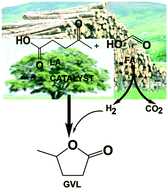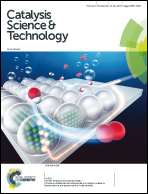Effect of SiO2 support properties on the performance of Cu–SiO2 catalysts for the hydrogenation of levulinic acid to gamma valerolactone using formic acid as a hydrogen source
Abstract
Vapor phase catalytic transfer hydrogenation of aqueous levulinic acid (LA) with formic acid (FA) as a hydrogen source was carried out over copper loaded on to several SiO2 supports having different physicochemical properties. The SiO2 supports and Cu–SiO2 catalysts with different support properties were characterized by XRD, TPR, XPS, NH3-TPD and UV-vis techniques to evaluate the copper species and its interaction with the support. The SiO2 support alone showed lower LA conversion and low selectivity to GVL whereas Cu–SiO2 catalysts were found to show high conversion and selectivity to the desired product with formic acid as the hydrogen source. The difference in the activities and product selectivity among different copper supported silica appears to be a complex function of acidity and the nature of copper species in the Cu–SiO2 catalysts. No direct correlation was observed between a specific catalyst property such as acidity and pore size, and the performance of the Cu–SiO2 catalysts. From the characterization, it appears that the species responsible for higher activity and selectivity to GVL are monomeric partially oxidized copper species in a strong interaction with the support in combination with a higher number of acid sites, both of which are present in Cu–SiO2-Q6. Cu–SiO2-Q6 showed the highest conversion and selectivity of 66 and 81%, respectively, under optimized conditions.



 Please wait while we load your content...
Please wait while we load your content...